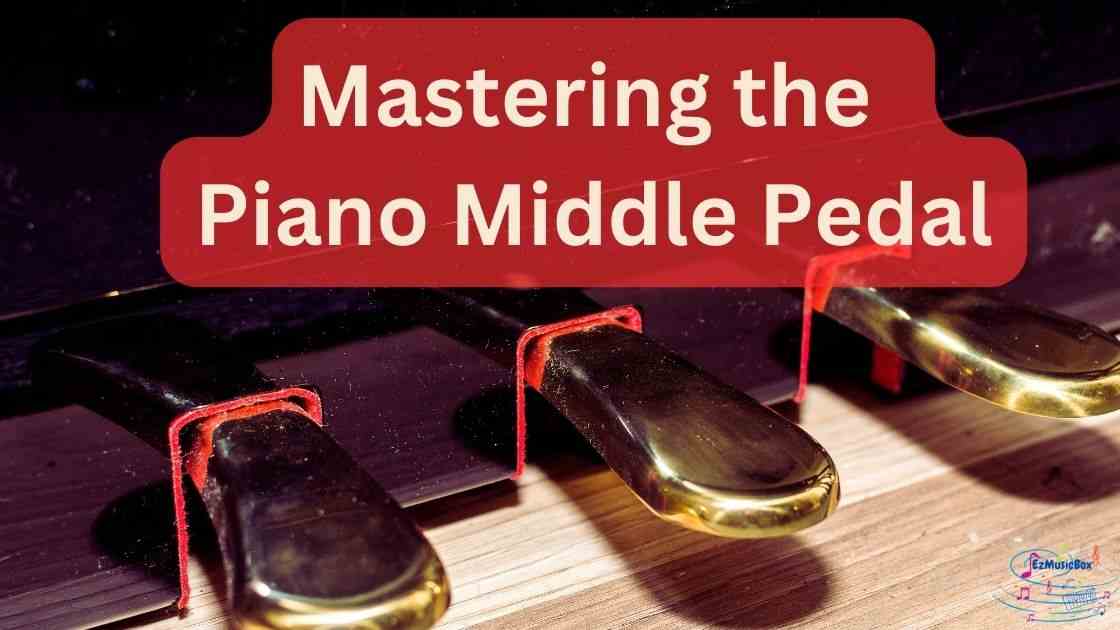What is the piano middle pedal, and how does it enhance your playing?
In this article, we’ll explore the unique capabilities of the piano middle pedal and its operating mechanism. Here, we provide insights into when and how to use it effectively to add texture and complexity to your musical expressions.
Table of Contents
Key Takeaways
- The middle pedal, or the sostenuto pedal, allows pianists to sustain selected notes while playing others unaffected, adding nuance and complex sound layering.
- A piano usually has three pedals. Different pedals serve specific purposes.
| The right pedal – the sustain pedal | This pedal is also known as the damper pedal. As the name indicates, it sustains all the notes you played. |
| The middle pedal – the sostenuto pedal | This pedal only sustains certain notes. |
| The left pedal – the soft pedal | Another name for this pedal is the una corda pedal. It creates a softer tone. |
- Digital pianos are designed to mimic the nuanced effects of acoustic piano pedals, including half-damper and selective note sustain capabilities.
The Sostenuto Pedal: The Middle Pedal on a Piano
The sostenuto pedal, often overlooked amidst the three piano pedals, is the middle child with a charm all its own.
Pioneered as a revolutionary addition to the piano’s capabilities, the sostenuto pedal has evolved to be more than just a pedal; it is a bridge to the piano’s soul, enabling you to sustain specific notes while the rest of the keyboard remains unaffected, free to weave in new sounds and rhythms.
Let’s peel back the curtain and see how this pedal works its magic.
How It Works

The sostenuto pedal operates through an ingenious mechanism within the belly of the piano. When you press a piano key and the sostenuto pedal together, a bar engages, hooking the damper away from the strings of the struck keys.
This action allows those specific notes to continue their resonant dance, unfettered by the dampers that would otherwise silence them.
The piano middle pedal allows pianists to sustain particular notes or chords, keeping the dampers elevated for these keys, even as they move on to play others unaffected, creating a tapestry of sound that is both complex and controlled.
History of the Sostenuto Pedal
The story of the sostenuto pedal begins with Albert Steinway, a visionary who patented this innovative pedal mechanism, forever changing the landscape of piano music.
While this novel feature spread across grand pianos, it became a playground for composers, inviting them to explore new textures and independently sustain specific notes or chords, as seen in the works of impressionist masters like Debussy and Ravel.
Yet, the sostenuto pedal’s journey has not been without its subtleties. While it offers a world of expressive possibilities, it remains relatively underutilized by beginners and is not essential for much of the traditional repertoire.
However, for those delving into the complex realms of modern pieces, the true sostenuto function becomes invaluable, providing a new dimension to the piano’s voice.
Sustain Pedal vs. Sostenuto Pedal
The sustain pedal, positioned on the right, is the grand marshal of the piano pedals, often used to create a wash of sound by lifting all the dampers off the strings, allowing all the notes to blend into a harmonious echo.
Its sweeping effect can envelop a room with sound, letting the piano’s strings resonate freely in a symphony of sympathetic vibrations.
In contrast, the sostenuto pedal is the selective artist, sustaining only the notes held at its engagement. This allows for a mix of sustained and non-sustained sounds within the same passage.
This precision allows pianists to layer their performance with textural effects, combining the sustained with the transient to create a nuanced musical landscape.

When to Use Each Pedal
Have you ever wondered when to employ the grandeur of the sustain pedal versus the precision of the sostenuto? Here are some tips:
The sustain pedal shines with legato pedaling, connecting notes smoothly and reducing blurriness in the sound.
- Preliminary pedaling, pressed before a note, adds resonance, enhancing its tone.
- Simultaneous pedaling provides rhythmic accentuation.
- Stopping the pedal pressing, the resonance ends.
The sostenuto pedal is ideal for:
- Holding onto certain notes or chords
- Creating a blend of sustained and staccato sounds
- Passages where clarity is key and every note needs to speak for itself without the overlay of others.
- No preliminary pedaling, only pressed with the notes or slightly after the notes are played.
Mastering the use of both pedals and the soft pedal allows you to expand your expressive palette and add depth to your musical storytelling with three pedals.
We have a dedicated article about piano pedals if you want to learn more.
Pedals on Upright Pianos
Upright pianos, with their more compact form and varied designs, offer a different pedal experience from their grand piano cousins.
The piano middle pedal, for instance, may not always be a sostenuto pedal; it often serves as a practice pedal or a bass damper pedal, adapting to the needs of the space and the pianist.
While variations exist, the right pedal, known as the damper pedal, remains consistent across both upright and grand pianos.
Let’s dive deeper into the specific roles of these pedals on upright pianos.
Practice Pedal
The practice pedal is a blessing for nocturnal musicians and those living close to one another. It tames the piano’s voice to a hush, allowing for hours of uninterrupted practice without a peep to the outside world.
This pedal operates by inserting a piece of cloth or felt between the hammers and the strings, a simple yet effective way to mute the sound while maintaining the touch and response of the keys.
In newer upright pianos, this middle pedal can even be locked in place, offering the luxury of extended muted practice sessions. The volume reduction it provides can vary, adding another dimension to the practice experience and allowing for discreet rehearsal at any hour.
Bass Damper Pedal
The bass damper pedal is a unique feature found on some upright pianos. It allows players to sustain only the lower bass notes, creating a foundation of sound that underscores the melody played with the right hand.
This pedal typically affects notes from A0 to D3 and can be particularly useful in pieces where a sustained bass line is essential to the musical texture.
The effectiveness of the bass damper pedal can vary with the size of the piano’s soundboard, which impacts the resonance of the bass strings.
Developing Your Pedaling Technique
The mastery of pedaling is as much an art as a skill, a balance between precision and intuition.
Mastering the sustain pedal is essential for beginners and intermediate players. This includes practicing techniques like half-pedaling and quarter-pedaling. Moreover, these skills offer pianists varying degrees of sustain and the ability to refine the nuances in their sound.
It’s about understanding the weight of your foot and the responsiveness of the pedal mechanism, a dance that is unique to each piano.
Then, learning how to use the piano middle pedal (the sostenuto pedal) will enhance your playing experience and enrich the color of your musical piece.
Active listening is crucial here. It’s about tuning in to the sound produced and adjusting your technique to achieve the desired musical effect.
Digital Pianos and Electronic Keyboards: Adapting Pedal Techniques
In the digital realm, pianos and keyboards continue the legacy of their acoustic piano counterparts, offering similar pedal functions that enrich the musical experience.
Sustain pedals on many digital pianos offer half-damper effects, allowing for subtle variations in the piano’s sound akin to acoustic pianos.
On the other hand, some beginner’s models may come with a footswitch in place of a sustain pedal. It will be beneficial to buy a sustain pedal that provides a more realistic piano pedal experience.

Similarly, electronic keyboards with sostenuto pedal capabilities offer a gamut of expressive possibilities. These pedals can detect varied positions, enabling performers to convey every shade of sustain and selective note-holding with digital precision, just as they would on a traditional piano.
Summary
As we conclude our journey through the world of piano pedals, we’re reminded of the rich tapestry of sound and silence they weave.
From the selective embrace of the sostenuto pedal to the damper pedal’s universal sustain and the una corda’s whispered touches, each pedal uniquely contributes to the pianist’s expressive palette.
Whether playing on a grand, an upright, or a digital instrument, mastery of these pedals unlocks new dimensions of musical storytelling.
Therefore, let this knowledge inspire you to explore the depths of your piano pedals, to practice with intention, and to listen with an attentive ear.
Play on, and let every note resonate with purpose.
Related Articles:

